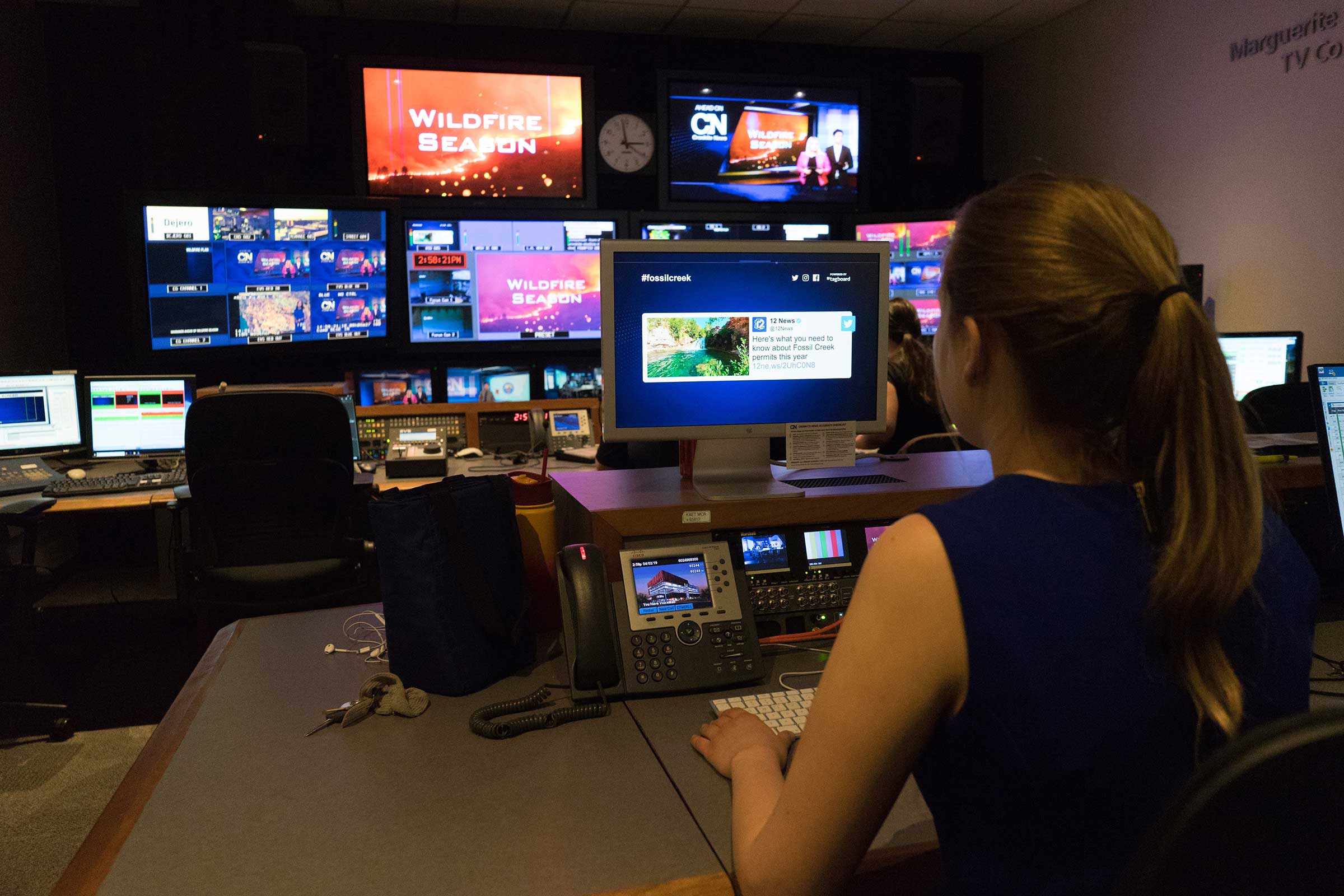ASU's Cronkite School partners with technology firms to bring innovation to TV newsrooms

Arizona State University’s Walter Cronkite School of Journalism and Mass Communication has launched working partnerships with several technology businesses to introduce innovative tools and ideas to broadcast newsrooms in the U.S. and abroad.
The Cronkite School is teaming up with Tagboard, AlertMe, Switcher Studio, iOgrapher and SPROCKIT on news innovation experiments with support from the John S. and James L. Knight Foundation to help transform local broadcast news.
“These alliances are an effective way to drive newsroom innovation,” said Frank Mungeam, who recently joined Cronkite as Knight Professor of Practice in TV News Innovation. “If we improve people’s tools, we can change their practices and the journalism they produce.”
Cronkite News, the student-staffed, faculty-led news division of Arizona PBS, serves as the incubator for many of the experimental tools being developed.
"Experimentation with and adoption of new technologies is both an opportunity and a challenge for broadcasters,” said Karen Rundlet, Knight Foundation director for journalism. “ASU's Cronkite School is preparing the next generation of news leaders to innovate across television's broadcast, digital, social and next-generation platforms. The industry is hungry for new ways to reach and inform audiences."
Each of the technology partners offers a specific opportunity for local journalism, Mungeam said. The partnership with Tagboard, a pioneer in social media curation and display, will focus on the improvement of social storytelling for broadcast news, including the curation and narrative display of social media posts by newsmakers and viewers.
AlertMe’s technology will allow Cronkite News readers and viewers to receive alerts when a story is updated, enabling them to personalize their experience through AI.
Cronkite News also is experimenting with iOgrapher and Switcher Studio on mobile storytelling and production. The two companies are providing training and equipment that will enable breaking news reporters to disconnect from the studio production booth and go live anywhere, using one or more smartphones.
Anchor Bayan Wong practices his rundown on Arizona wildfire season in the Cronkite News newsroom on ASU's Downtown Phoenix campus April 2. Photo by Victor Ren
SPROCKIT will identify new technologies and pair startups with corporate media partners, keeping the connections between local news organizations and emerging technologies fresh.
Harry Glazer, SPROCKIT founder and CEO, said, “Cronkite’s commitment to news innovation makes it a great place to incubate these startups’ technology in ways that can be scaled to commercial news organizations.”
Nathan J. Peterson, the chief revenue officer for Tagboard, said he hopes the experiments will help companies learn how to encourage “diverse perspectives through real-time social content, fueling truthful, impactful stories as they break. In an ever-evolving media landscape, the world needs more innovative journalists who know how to leverage technology to find the truth in a story.”
Cronkite News producer Emily Giordano makes a slideshow on the Valley's biggest news stories using the social media display program Tagboard. Photo by Victor Ren
The technology partnerships continue a long tradition of innovation and collaboration at Cronkite, said Mark Lodato, the school’s associate dean. “We’re committed to continuing to be at the forefront of developing the future of local news,” he said.
The collaborations also benefit Cronkite News journalists.
“The opportunity to use these technologies helps our students expand their storytelling skills and better equips them to transform the newsrooms they’ll join after they graduate,” said Christina Leonard, executive editor of Cronkite News.
Examples of these experiments at Cronkite News were to be presented April 7 at the National Association of Broadcasters conference in Las Vegas. Mungeam and Andrew Heyward, senior research professor for TV news at the Cronkite News Lab, shared best practices from the news industry and experiments during a Digital Futures Exchange panel.
Top photo: Cronkite student Adrian Marsh develops Snapchat stories in Adobe Photoshop about the proposed closure of the southern U.S. border. Photo by Victor Ren
More Law, journalism and politics
Can elections results be counted quickly yet reliably?
Election results that are released as quickly as the public demands but are reliable enough to earn wide acceptance may not always be possible.At least that's what a bipartisan panel of elections…
Spring break trip to Hawaiʻi provides insight into Indigenous law
A group of Arizona State University law students spent a week in Hawaiʻi for spring break. And while they did take in some of the sites, sounds and tastes of the tropical destination, the trip…

LA journalists and officials gather to connect and salute fire coverage
Recognition of Los Angeles-area media coverage of the region’s January wildfires was the primary message as hundreds gathered at ASU California Center Broadway for an annual convening of journalists…



